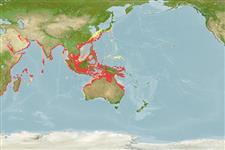Common names from other countries
Malacostraca |
Decapoda |
Scyllaridae
Environment: milieu / climate zone / depth range / distribution range
Ecology
Benthic; depth range 8 - 100 m (Ref. 4), usually 10 - 50 m (Ref. 4). Tropical, preferred 28°C (Ref. 107945); 36°N - 31°S, 30°E - 155°E (Ref. 4)
Indo-West Pacific.
Length at first maturity / Size / Weight / Age
Maturity: Lm ?, range 11 - ? cm Max length : 27.7 cm TL male/unsexed; (Ref. 122432); 27.5 cm TL (female)
It has lengths of 25 cm, maximum total body length; 8 cm, maximum carapace length (Ref. 4). Prefers soft substrate of sand or mud, or a mixture of the two, sometimes with shell or gravel (Ref. 4). Subtidal, also found on hard bottom (Ref. 106854).
Mating behavior: Precopulatory courtship ritual is common (through olfactory and tactile cues); usually indirect sperm transfer (Ref. 833). Also Ref. 107577.
Holthuis, L.B. 1991. (Ref. 4)
IUCN Red List Status
(Ref. 130435: Version 2025-1)
CITES status (Ref. 108899)
Not Evaluated
Not Evaluated
Threat to humans
Human uses
Fisheries: commercial
FAO - Aquaculture: production; Fisheries: landings | FishSource | Sea Around Us
Tools
More information
PhysiologyOxygen consumption
Human RelatedStamps, coins, misc.
Internet sources
Estimates based on models
Preferred temperature
(Ref.
115969): 25.4 - 29, mean 28.1 (based on 1518 cells).
Fishing Vulnerability
Moderate vulnerability (38 of 100).
Climate Vulnerability
High vulnerability (56 of 100).
Nutrients : Calcium = 109 [35, 184] mg/100g; Iron = 1.59 [1.21, 1.97] mg/100g; Protein = 20.2 [19.2, 21.3] %; Omega3 = 0.285 [0.185, 0.386] g/100g; Selenium = 48.3 [-31.7, 128.3] μg/100g; VitaminA = 0 μg/100g; Zinc = 1.79 [1.17, 2.40] mg/100g (wet weight); based on
nutrient studies.
